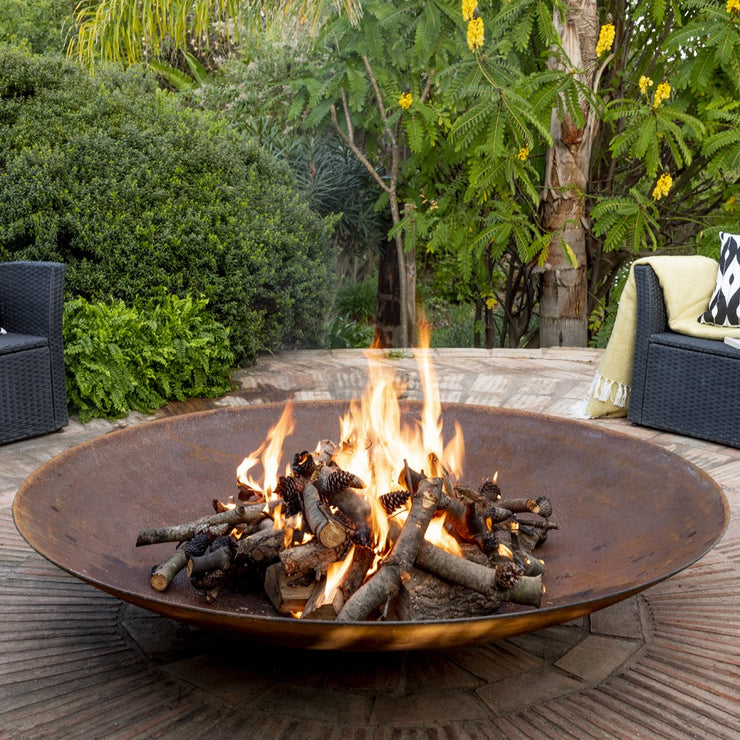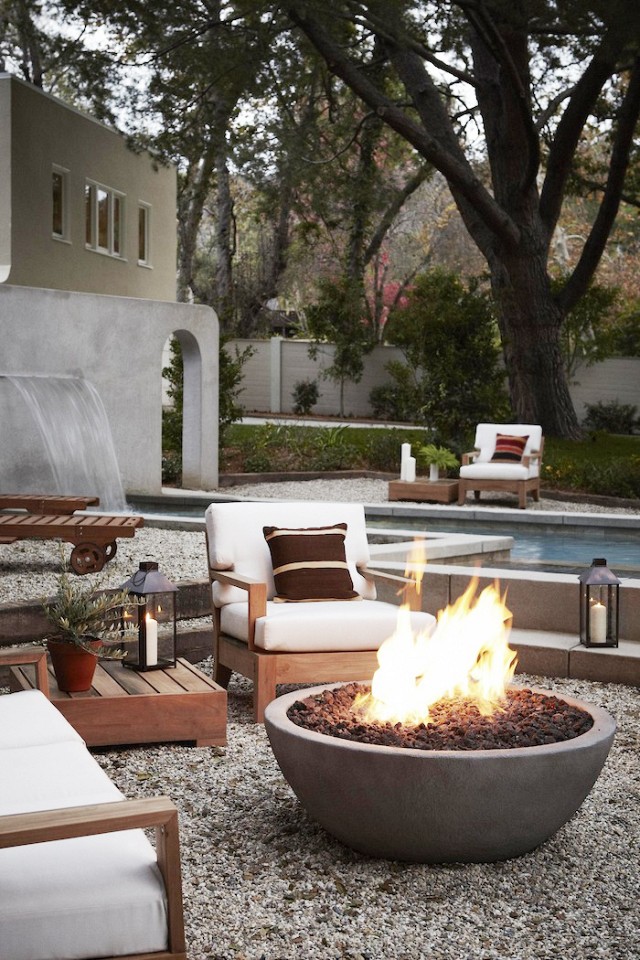Call us at 725-239-9966!
M-F: 8 AM-7 PM PST
Call us at 725-239-9966!
M-F: 8 AM-7 PM PST

A glowing fire feature can instantly elevate an outdoor space. As you think about adding a new fire installation to your backyard, deck, or patio, two options likely come to mind - fire bowls or outdoor fire pits. But what exactly is the difference, and how do you choose between these quintessential outdoor centerpieces?
This in-depth guide examines key distinctions when deciding between fire bowls and fire pits for your outdoor living area. We compare critical factors - from movability and guest capacity to heat output and design. Read on to determine the best option for your needs.
Fire bowls offer mobility and flexible placement, while fire pits provide a permanent gathering spot. Bowls can be moved, pits stay fixed.
Fire pits accommodate larger groups and radiate more warmth, as their fire beds are bigger. Bowls better suit small patios and 3-6 people.
Both fire installations ignite striking style. Pits embody rustic nostalgia, bowls enable vibrant designs and colors.
Bowls range $100-$2000 based on size and material. Pits cost $200-$5000+. Factor long-term fuel costs too.

Before weighing specific factors, let’s clarify the definitions:
Fire bowls: Metal, ceramic, or stone vessels, typically 1.5-3 feet wide and mostly round in shape. They usually have an open top and sit above ground on legs or a stand. Fire bowls enable fires without a fixed permanent structure.
Fire pits: Any fire installation set into or built on top of the ground, often made of stone, metal, or ceramic material. Fire pits can be round, square, rectangular, or custom shapes.
In short - fire bowls offer portable, decorative flair, while fire pits provide classic, robust fire enjoyment.
Outdoor fire fixtures check several boxes - warmth, beauty, and gathering place. Assessing your needs and priorities will steer you toward the best choice. Here are key considerations when reviewing fire bowls vs firepits:
Fire bowls shine for mobility and flexibility since their stand-alone design enables easy repositioning. Most models have handles and weigh less than 75 pounds. You can use a fire bowl in your backyard, then conveniently move it to the patio to alter your outdoor living scheme.
On the other hand, fire pits sit stationary in a fixed spot. If ultimately opting for a custom built-in pit, carefully consider placement based on seating, views, and proximity to your home.
When enjoying a fire feature with family and friends, scale matters. Compare dimensions and fuel load capacities when deciding between fire bowls vs fire pits.
Fire pits tend to be larger - ranging from 3-5 feet in diameter on average. Their fuel beds handle bigger logs and higher wood volume. The largest fire pit designs accommodate groups of 10-15 people.
Conversely, fire bowls measure 1.5-3 feet across. Smaller bowls comfortably seat 3-4 adults, while larger vessels can gather 6-8 people. Match the size with your typical guest count.

Fire bowls and fire pits offer multiple fuel alternatives - wood, natural gas, propane, and bioethanol. Assess the trade-offs for your lifestyle and preferences.
For wood-burning options, both fire vessels will produce trademark crackling fires and sweet wood smoke. You’ll need a steady supply of firewood and a safety screen.
Propane fire pits mean no smoke or ash to clean up. Simply connect the line from a standard tank to an adjustable burner that can last for up to 10 hours per 20-lb. tank depending on the size. Fire bowls also accommodate tabletop propane canisters that may only last a few hours.
Natural gas fire installations offer convenience without portable tanks, pending access to an existing gas line. Professional help is recommended for installation.
Bioethanol doesn’t emit smoke and burns clean. Fire bowls commonly use bioethanol canisters, lasting 4-6 hours per fill. There’s no wood chopping or tank refills.
A glowing fire warms body and soul. But with outdoor vessels, heat output varies.
Fire pits excel at heating due to greater cubic footage and ventilation. Pit fire beds stand 6-12 inches above ground draft and circulate heat effectively. Larger masonry fire pits distribute warmth across a 15-30 foot diameter.
Tabletop fire bowls radiate heat in a smaller ring, within a 6-15 foot range. Fewer heat projects vertically, so position bowls at standing height. Measure BTUs when comparing fire bowl models for warmth potential.
Beyond heating functionality, fire pits and fire bowls each make stunning design statements. Consider the look you envision before selecting a model.
Fire pits embody classic charm - intimate gatherings around cracking, aromatic fires. Stone or brick pits send a traditional, rustic vibe. Copper, iron, and steel designs adopt a more contemporary, sleek look. Custom built-in fire pits use masonry to match landscape schemes.
Alternatively, fire bowls ignite bold, artistic flair through vibrant colors, shapes, and materials. Intricate glass, modern concrete, and handcrafted ceramic bowls morph into functional yard sculptures. Some mimic wood piles, flowers, or abstract shapes. Tailor style and finishes to your personality.

With vast design and material options for fire pits and fire bowls, costs cover a wide spectrum.
Fire Pit Cost Range:
Fire Bowl Cost Range:
Factor long-range budget by weighing construction or installation fees of firepits against ongoing fuel expenses. For example, wood-burning fires have higher overall costs versus propane's lower install price but continual tank refill fees.
Looking at upfront costs and long-term expenses, here is how fire pits and fire bowls compare budget-wise:"
| Feature | Fire Pit | Fire Bowl |
|---|---|---|
| Upfront Cost Range | $200 - $5,000+ | $100 - $2,000 |
| Typical Fuel Type | Wood | Bioethanol, propane |
| Fuel Ongoing Cost | Higher | Lower |

Based on the comparisons above, what are the core benefits of fire bowls and fire pits?
Fire Bowl Advantages
Fire Pit Benefits

With greater scale and heating reach, permanent fire pits warm more friends over years of gatherings. Also, for robust and nostalgic backyard fires perfect for parties, fire pits surpass decorative bowls with custom elegance anchored in tradition.
If you need guidance on selecting the ideal fire pit after weighing these comparisons, check out our fire pit buyer's guide which covers critical specifications like shape, material, safety, placement, and more.
However if still confused whether a stunning yet functional fire bowl or classic fire pit belongs in your backyard? Contact our fire feature experts today. Describe your dream outdoor space and challenges and we’ll recommend the ideal warming fire solution.
Both fire pits and bowls can produce substantial flame, but it depends on the size of the fire feature and the materials you're using. Wood burning can produce a larger flame, but remember that larger flames can also mean less safety if left unattended. Always keep an extinguisher handy and review your outdoor fire safety policy periodically.
When you’re considering the right choice between a firepit and a fire bowl, it’s important to consider your space, how you'll use it, safety, and privacy. If you want to enjoy a fire but don’t have space for a full outdoor dining set, a fire bowl may be your answer. If you plan on having friends and family over to enjoy a meal around the fire, then a fire table designed to fit your patio furniture would be best for your needs.
Fire bowls can become the centerpiece of any outdoor space, providing not only heating but also lighting. How you use them largely depends on your needs and preferences. You could mount a fire table in the center of your outdoor dining area, or you could place it somewhere that maximizes privacy.
Typically, you can burn wood or charcoal. However, it's important to remember that not all materials are safe to burn. Burning certain types of wood or other items can release potentially harmful chemicals into the air. Ensure you're aware of the best practices before you light up your firepit or fire bowl.

{"one"=>"Select 2 or 3 items to compare", "other"=>"{{ count }} of 3 items selected"}
Leave a comment